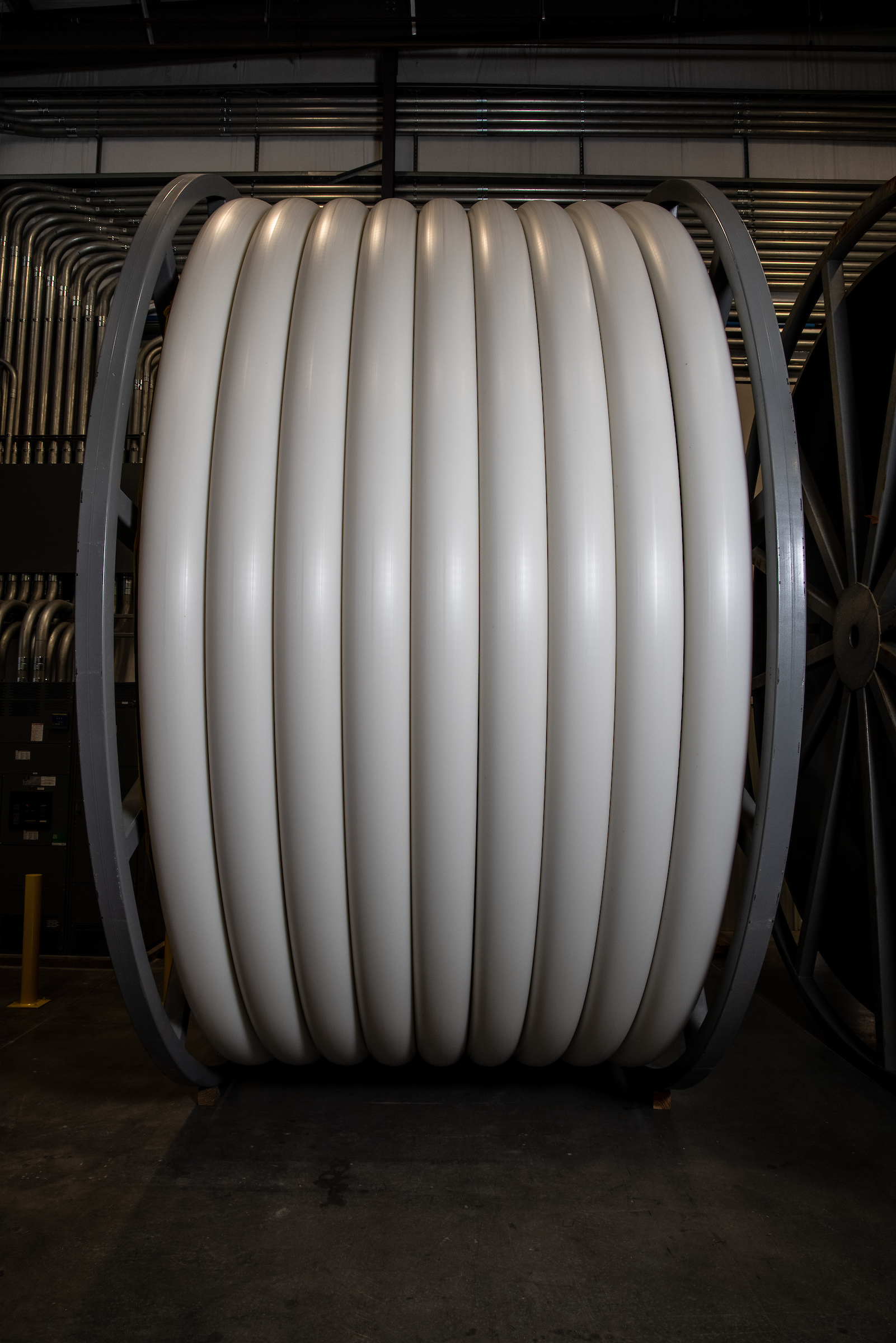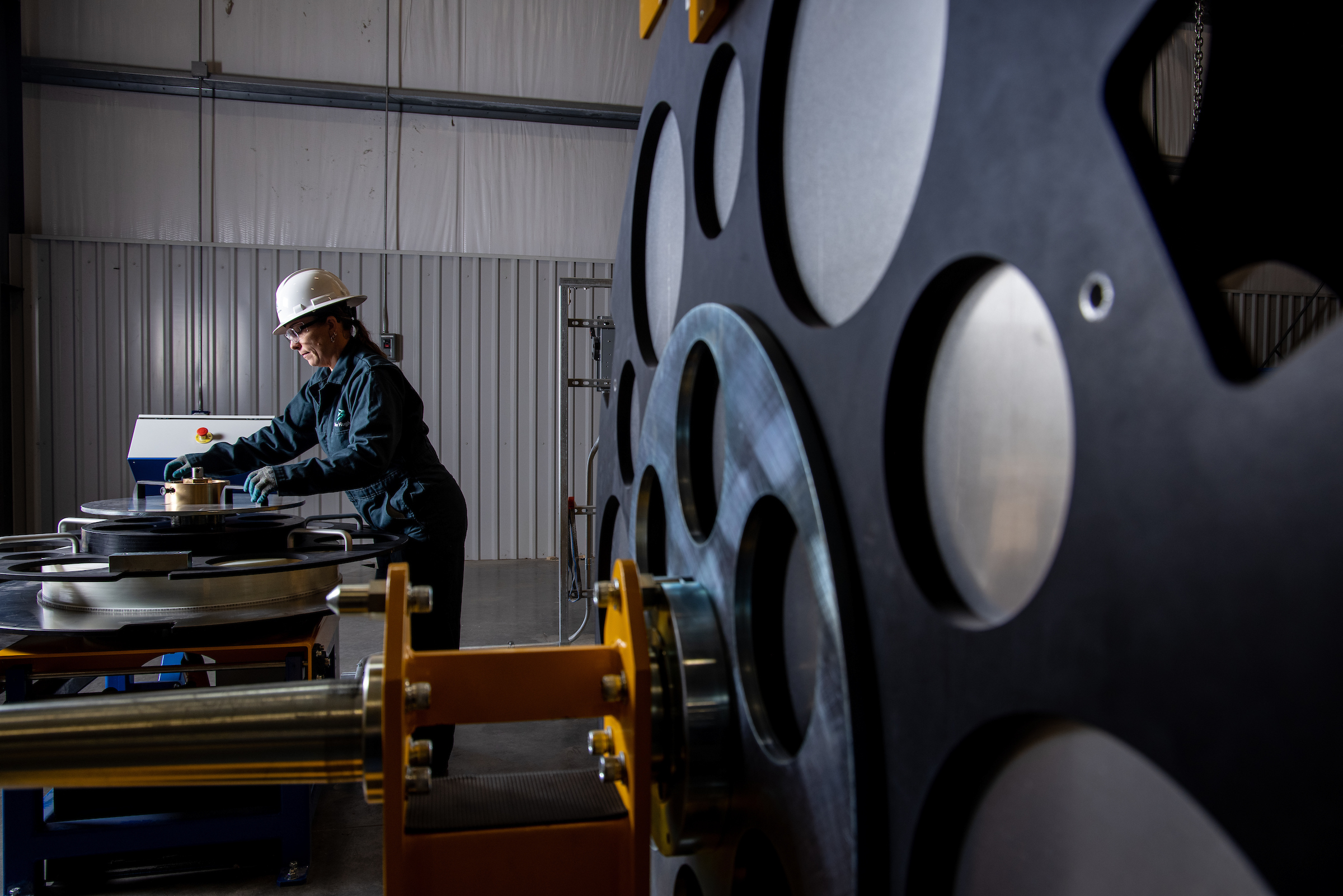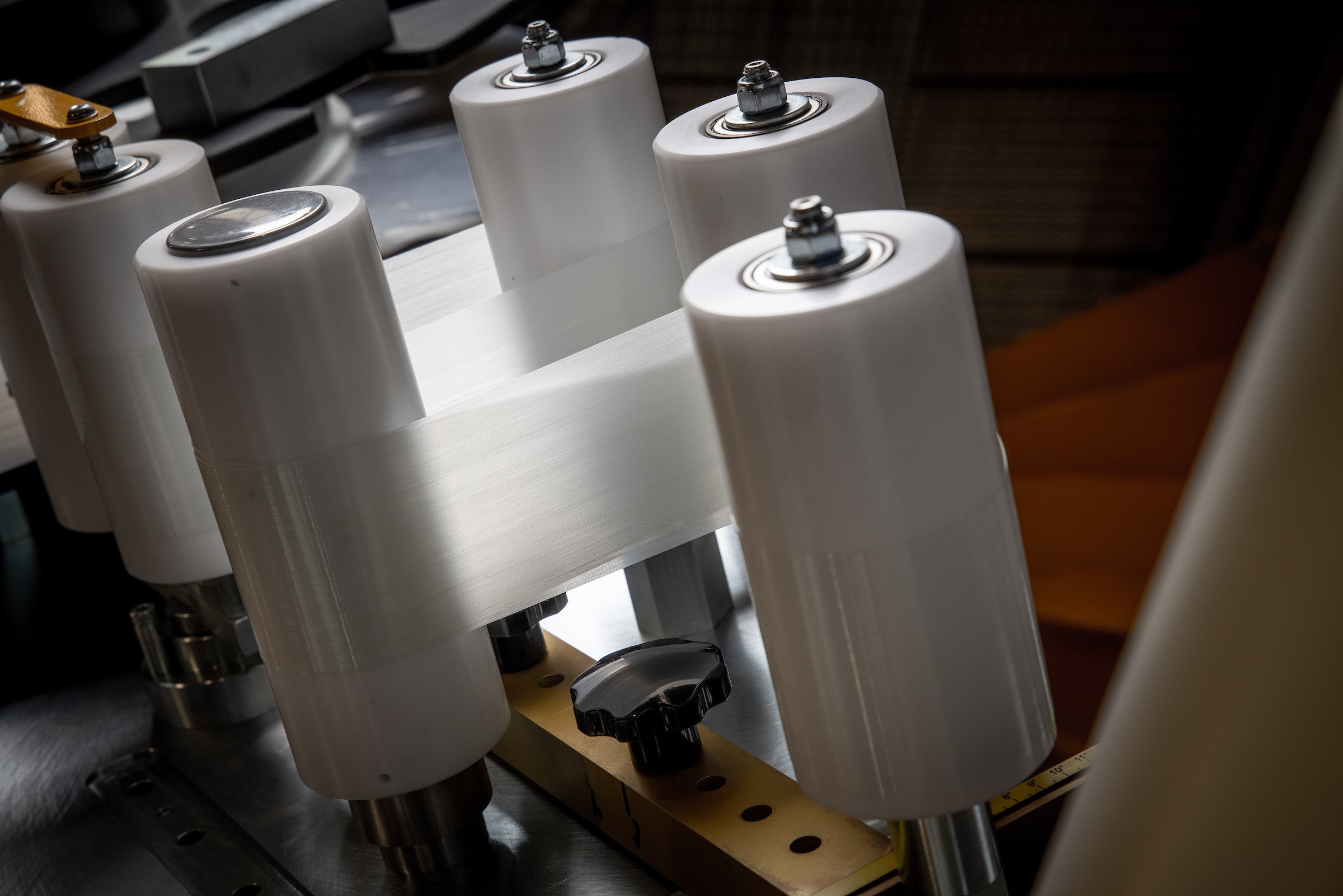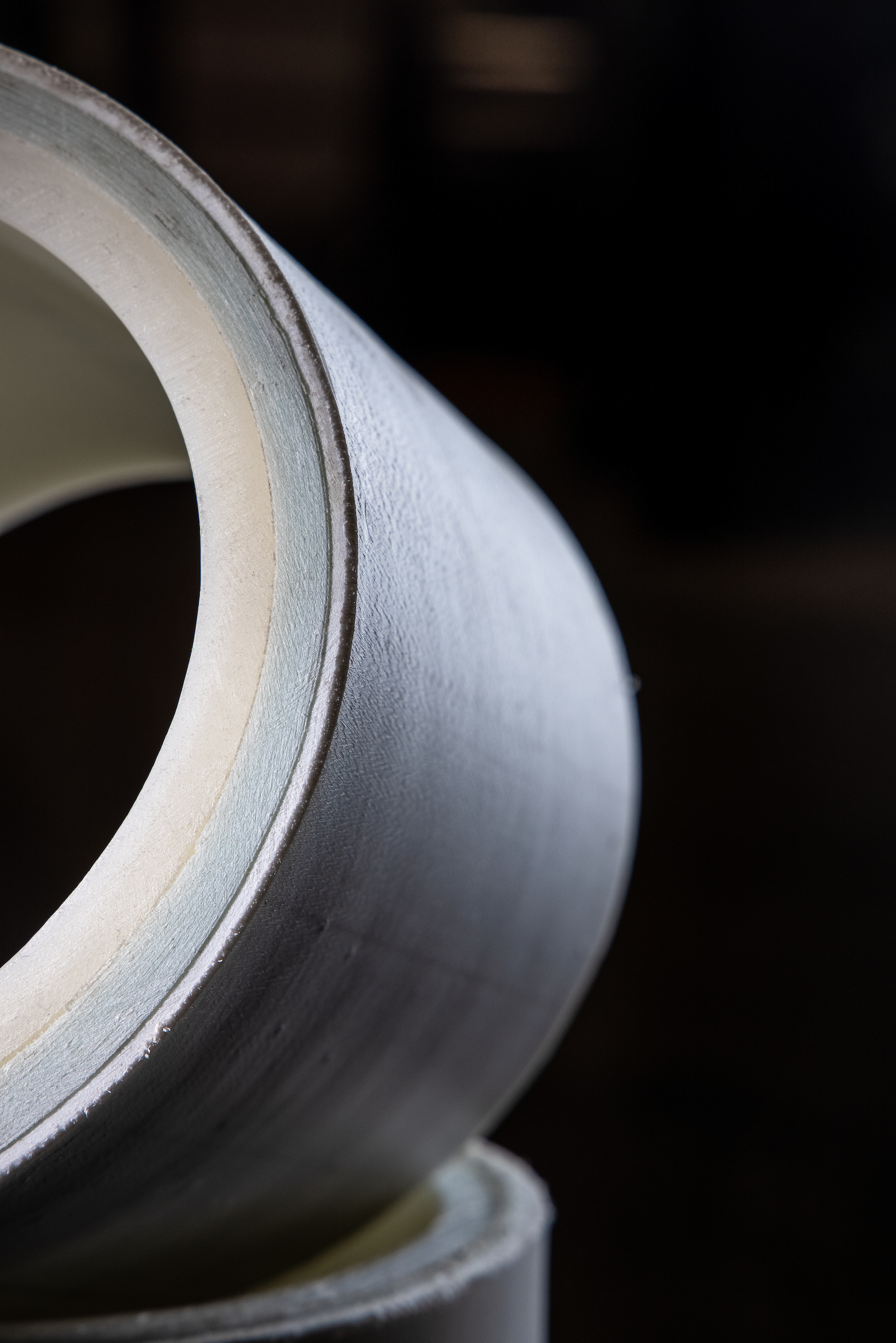For more than a century, the technology used for transporting pressurized fluids – liquid or gas – has continually evolved from wood, to clay, to lead, then cast iron, and, currently, steel pipelines. Meet the latest industry disruptor: composite flexible pipe. This next generation of non-metallic pipe is a proven alternative for a fast-growing range of applications.
What is non-metallic pipe and what makes it different? Lightweight and flexible, reinforced thermoplastic pipe can optimize the core structure of flowline and pipeline networks and economically support the transport of CO2 for storage, the movement of hydrogen, or the conversion of existing infrastructure to carry these gases, which will be critical in the energy transition and decarbonization of industry.
At Baker Hughes, we’re manufacturing the next generation of onshore flexible pipe at our state-of-the-art facility in Houston. So here, we explore the seven superpowers of these non-metallic onshore pipelines:
1. Flexible
Let’s start with the inherent flexibility of the product, which brings benefits both as it is installed, and as it is operating.
This pipe is a very easy product to get into a ditch: you can lift it, you can bend it. If you are trying to do that with steel pipe, you need three or four side booms and a big bulldozer for starters. This means a lot of safety exposure, because steel has that rigidity and weight, so when you are working with anything made from steel, it’s an extra overhead to carry.
Flexibility (or compliance) is equally important when the pipe is in service. Not all land where operators need to lay pipelines is neat and compact and solid. You may need to cross geo-hazards of all sorts, such as landslides, mud, and swamps. This presents considerable risk for steel pipe and to overcome it, operators have traditionally relied on a huge amount of extra design effort up front and added structural capacity such as expansion loops (basically large U-bends in the pipe) or weak links with quick disconnect valves. Pipeline operators are always working to avoid spills of oil or gas, or even brines, so there is a heavy burden of responsibility, and operators must have that extra flexibility engineered into their steel pipeline system. Composite line pipe just doesn’t have the same level of risk because it's flexible and can easily incorporate bends and loops which would facilitate any ground movement – just using its natural compliance.

2. Robust
Strength is relative and people confuse strength with rigidity. It is perhaps best to talk about a product having ‘deep robustness’. The reason for the remarkable shift to composite materials in the past 20 years is that they can be very, very robust. Let’s take aircraft structures as an example. They are not being used just in bulkheads and seats; the wings and load-bearing components are now made from both metallic and non-metallic composites. When something hits it at high speed, such as bird strike, a composite absorbs way more energy than a solid or dense material.
In the working environments for pipelines, there are high shock loads, heating and cooling cycles and pressure cycles, a material with high ductility will likely be more reliable than something that is rigid.
The pipes are designed for extreme events and then safety factors are added on top, so that they are fit for a given duty, however they can perform well beyond these design parameters, in what we would call “upset conditions” for short periods of time. Enough margin of safety must be built in to allow for those unforeseen events, that may test the robustness of the pipe during its life.
3. Connected
Non-metallic pipes are both connected and connectable.
Strain gauges, electronic sensors, and fiber-optic sensors have traditionally been fitted to steel pipe for specific applications, usually condition monitoring. But this means gluing something that is not homogenous with the steel on the outside of the structure, possibly even outside the insulating coating. The operator is then totally reliant on the bond and the fiber-optic sensor or electrical gauge maintaining its life and deriving what’s going on inside the pipe from the outside.
This superpower for flexible composite pipes is that the optical fibers can be embedded in the structure itself, as they are compatible with the reinforcement material used. Optical-fiber monitoring is an incredibly versatile tool for condition monitoring and integrity assessment. A standard telecom-grade fiber is embedded within the structure with the other fibers and becomes an integral part of the pipe.
On a pipe running for 20 miles with embedded optical fiber, we can measure all sorts of things – such as distributed temperature – along that complete distance. For example, with fiber optic pipeline monitoring, if there is a leak from the inside out, or from the outside in, the temperature difference will show up on the monitoring software. We can then investigate that specific location, without the need to dig up miles of pipe.
One capability that is most interesting is the use of optical fibers for vibration monitoring. With an I/O box (input/output) at one end and a reflector at the other, we can interrogate the line signal backwards and forwards. When monitoring the fiber acoustically, vibrations will be detected if for example somebody’s digging in the vicinity. This means in advance of somebody digging a hole near and potentially ‘interacting’ with the pipe, the operator will get a warning. The value of that alarm capability for operators is obvious.
What is less obvious is that operators have a regulatory duty to positively confirm the condition of the pipeline, including that it is holding pressure, shows no signs of being degraded, and is still fit for purpose. These on-board monitoring systems allow the operator to do these checks without having to inspect the line either internally, with an intelligent pig, or externally by walking along it. A step forward in the digitalization of operations.

4. Safe
Operators and services companies alike are committed to safety as a non-negotiable and work together to minimize both the probability of something happening and to mitigate any adverse consequence if it does. In the energy sector, moving heavy items of machinery or equipment is one of the most dangerous activities, and where people have the greatest risk of getting hurt.
Composite flexible pipe brings a very simple superpower here – it is lighter than steel pipes and it fits on a reel.
This fundamental characteristic reduces the probability and the consequence of injury. Instead of many heavy steel pipes loaded onto as many as 20-30 trucks arriving at a site, we have one reel of very lightweight pipe on one truck. So statistically, this immediately reduces the exposure to road accidents, as well as reducing the lifting and dropping hazards associated with moving steel pipe joints onto and off a truck.
The installation of a steel pipeline involves welding, bending, side booms, and a lot of heavy pieces of equipment. A composite flexible pipe installation will require much less. A backhoe will open the ditch and either the backhoe or a few people can manually lift the pipe into the trench, and 100s of meters of flexible can be laid without interruption for connectors or welding. The reduced number of joints also lowers the risk of a leak during hydrotesting operations.
In short, the whole construction operation is substantially de-risked: far fewer people, a lot less equipment, and the operations are much simplified.
In addition, the operational risk of wall thickness loss due to corrosion, one key factor of steel-pipe failure, is non-existent in a non-metallic onshore pipeline.
5. Cleaner
The composite pipes are fully recyclable at the end of life and are as simple to replace or remove as they were to install. During installation there is at least 30% less land required for the right-of-way, when dealing with many fewer vehicle movements – this has an environmental benefit as well as improving the owner/operator’s return on investment. Of course, many fewer vehicles for transportation and installation also means lower emissions.

As the inside of composite pipes is very smooth, this means that a smaller diameter pipe can achieve a better flow rate for fluid transportation, once again impacting efficiency, project cost and environmental footprint.
6. Budget
The project manager is responsible for the budget and their first question is, ‘How much am I spending upfront?’ With non-metallic pipes, the discussion moves from comparing equipment unit costs, which is what the industry normally focuses on, to look instead at total installed cost. When we take the cost of our pipe, the cost of installation, and the cost of the operation, we can demonstrate that in most applications, this pipe is significantly – 20-30% and sometimes more – lower than the installed cost of the equivalent steel pipe.
When looking at OPEX, the operator can benefit from a hidden cost advantage: there is no need to inject chemicals into the pipes to prevent corrosion, which can be costly. Oxygen scavengers and wax build up are also not an issue, which eliminates regular intelligent pigging operation. Likewise, external corrosion – requiring a Cathodic Protection system installation and life-long maintenance – are not needed. A consideration of all those ‘traditional’ pipe maintenance items greatly reduces the operating costs of the pipeline over its life cycle.
7. Advanced
Composite pipes are a great example of the benefits achieved with advanced configuration and manufacturing. We work from a menu of components which can change out quickly. We use the same machinery and, in some cases, the same kind of base materials – the composite fiber tapes and polymers. If the operating duty requires it, we can substitute a high-temperature polymer or an impermeable polymer inside the pipe and leave everything else unchanged.
As with additive manufacturing, the technology used to produce these pipes means each structure can be optimized to the needs of the application. Our manufacturing capability can make a pipe of any diameter, refine the pressure rating by applying more or fewer layers, add or subtract stiffness, add temperature capacity, and so on, to be just right for its application.

A steel pipe is built to an API standard, so the operator will get a four-inch pipe, a six-inch pipe, or an eight-inch pipe and there is very little difference between them other than wall thickness (pipe schedule). The actual amount of steel needed to resist pressure is relatively small, but the standard calls for additional material to be added to cope with bending loads, and extra safety and corrosion allowances, carrying a lot of redundancy in a standard steel pipe design.
Composite is also a very quick manufacturing process – a length of flexible pipe can be produced in a matter of days if needed. Steel pipe joints may need to be ordered many months in advance from the mill in order to get the specified grade, whereas we can build a variety of products, in days, from the same base raw materials.
Energy Forward Stories
Sign up to stay up to date on the latest innovations and people shaping the future of our industry.





